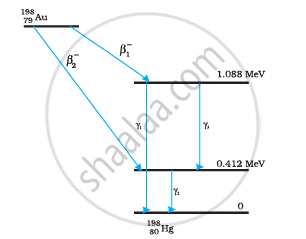Advertisements
Advertisements
Question
Ten grams of 57Co kept in an open container beta-decays with a half-life of 270 days. The weight of the material inside the container after 540 days will be very nearly
Options
10 g
5 g
2.5 g
1.25 g
Solution
10 g
57Co is undergoing beta decay, i.e. electron is being produced. But an electron has very less mass (9.11×10-31 kg) as compared to the Co atom. Therefore, after 570 days, even though the atoms undergo large beta decay, the weight of the material in the container will be nearly 10 g.
APPEARS IN
RELATED QUESTIONS
For the `beta^+` (positron) emission from a nucleus, there is another competing process known as electron capture (electron from an inner orbit, say, the K−shell, is captured by the nucleus and a neutrino is emitted).
\[\ce{e+ + ^A_Z X -> ^A_{Z - 1}Y + \text{v}}\]
Show that if `beta^+` emission is energetically allowed, electron capture is necessarily allowed but not vice−versa.
Consider the D−T reaction (deuterium−tritium fusion)
\[\ce{^2_1H + ^3_1H -> ^4_2He + n}\]
Calculate the energy released in MeV in this reaction from the data:
`"m"(""_1^2"H")`= 2.014102 u
`"m"(""_1^3"H")`= 3.016049 u
Consider the D−T reaction (deuterium−tritium fusion)
\[\ce{^2_1H + ^3_1H -> ^4_2He}\]
Consider the radius of both deuterium and tritium to be approximately 2.0 fm. What is the kinetic energy needed to overcome the coulomb repulsion between the two nuclei? To what temperature must the gas be heated to initiate the reaction? (Hint: Kinetic energy required for one fusion event =average thermal kinetic energy available with the interacting particles = 2(3kT/2); k = Boltzman’s constant, T = absolute temperature.)
Obtain the maximum kinetic energy of β-particles, and the radiation frequencies of γdecays in the decay scheme shown in Fig. 13.6. You are given that
m (198Au) = 197.968233 u
m (198Hg) =197.966760 u

Write the basic nuclear process underlying β+ and β– decays.
Write the β-decay of tritium in symbolic form.
Write the basic nuclear process of neutron undergoing β-decay.
Why is the detection of neutrinos found very difficult?
In beta decay, an electron (or a positron) is emitted by a nucleus. Does the remaining atom get oppositely charged?
Consider a sample of a pure beta-active material.
A free neutron beta-decays to a proton with a half-life of 14 minutes. (a) What is the decay constant? (b) Find the energy liberated in the process.
(Use Mass of proton mp = 1.007276 u, Mass of `""_1^1"H"` atom = 1.007825 u, Mass of neutron mn = 1.008665 u, Mass of electron = 0.0005486 u ≈ 511 keV/c2,1 u = 931 MeV/c2.)
Complete the following decay schemes.
(a) `"" _88^226Ra → alpha+`
(b) `""_8^19O → _9^19F+`
(c) `""_13^25Al → ""_12^25Mg+`
A free neutron decays into ______.
